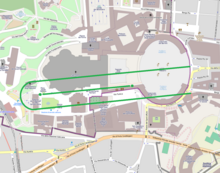St. Peter's Square
St. Peter's Square
Piazza San Pietro | |
|---|---|
| City square | |
Gianlorenzo Bernini | |
| Location | Vatican City |
 Click on the map for a fullscreen view | |
| Coordinates: 41°54′08″N 12°27′26″E / 41.9022°N 12.4572°E | |
Saint Peter's Square (
At the centre of the square is the

History

The open space which lies before the basilica was redesigned by Gian Lorenzo Bernini from 1656 to 1667, under the direction of Pope Alexander VII, as an appropriate forecourt, designed "so that the greatest number of people could see the Pope give his blessing, either from the middle of the façade of the church or from a window in the Vatican Palace".[4] Bernini had been working on the interior of St. Peter's for decades; now he gave order to the space with his renowned colonnades, using a simplified Doric order,[5][6] to avoid competing with the palace-like façade by Carlo Maderno, but he employed it on an unprecedented colossal scale to suit the space and evoke a sense of awe.
There were many constraints from existing structures (illustration, right). The massed accretions of the
According to the Lateran Treaty the area of St. Peter's Square is subject to the authority of Italian police for crowd control even though it is a part of the Vatican state.
Colonnades

The colossal Doric colonnades, four columns deep,[9] frame the trapezoidal entrance to the basilica and the massive elliptical area[10] which precedes it. The ovato tondo's long axis, parallel to the basilica's façade, creates a pause in the sequence of forward movements that is characteristic of a Baroque monumental approach. The colonnades define the piazza. The elliptical center of the piazza, which contrasts with the trapezoidal entrance, encloses the visitor with "the maternal arms of Mother Church" in Bernini's expression. On the south side, the colonnades define and formalize the space, with the Barberini Gardens still rising to a skyline of umbrella pines. On the north side, the colonnade masks an assortment of Vatican structures; the upper stories of the Vatican Palace rise above.
Obelisk

At the center of the ovato tondo stands the

The Emperor

Paving
The paving is varied by radiating lines in travertine, to relieve what might otherwise be a sea of setts. In 1817 circular stones were set to mark the tip of the obelisk's shadow at noon as the sun entered each of the signs of the zodiac, making the obelisk a gigantic sundial's gnomon. Below is a view of St. Peter's Square from the cupola (the top of the dome) which was taken in June 2007.
Spina
St. Peter's Square today can be reached from the
See also
References
- ^ William Tronzo, ed., St. Peter's in the Vatican, Cambridge University Press, 2005, page 149.
- ^ Franco Mormondo, Bernini: His Life and His Rome, University of Chicago Press, 2011, page 203.
- ISBN 9780500231074.
- ^ Norwich (1975), p. 175)
- ^ William Tronzo, ed., St. Peter's in the Vatican, Cambridge University Press, 2005, page 149.
- ^ Franco Mormondo, Bernini: His Life and His Rome, University of Chicago Press, 2011, page 203.
- ^ It was set up in 1613 by order of Paul V
- ^ The actual foci are marked in the paving by roundels of stone six or seven metres beyond the outer ring of the compass rose centered on the obelisk, on either side. When the visitor stands on one, the ranks of columns line up perfectly behind one another. (Touring Club Italiano, Roma e Dintorni).
- Alexander VII.
- ^ The ovato tondo is 240 metres across.
- ^ Touring Club Italiano, Roma e Dintorni, which furnishes the statistics in these notes.
- ^ Based on "Outline of St. Peter's, Old St. Peter's, and Circus of Nero".
Further reading
- Hibbert, Christopher, 1985, Rome: The biography of a city, London, Penguin.
- Norwich, John Julius, ed. 1975 Great Architecture of the World ISBN 0-394-49887-9
- Touring Club Italiano, Roma e Dintorni
External links
| External videos | |
|---|---|
- stpetersbasilica.info Pages for all 140 Colonnade Saints
- Great Buildings On-line: Piazza of St. Peter's
- Roberto Piperno, "Piazza di S. Pietro": engravings by Vasi
- Mary Ann Sullivan, "St Peter's Piazza, Vatican City"
- Obeliscus Vaticanus LacusCurtius.com, The Vatican obelisk, retrieved September 4, 2006
- The legend of the cry of Bresca Legendary Rome
- Rome, Nova Online, Mysteries of the Nile, A World of Obelisks: Rome pbs.org, retrieved September 4, 2006
- St. Peter's Square, Bernini's Fountain




